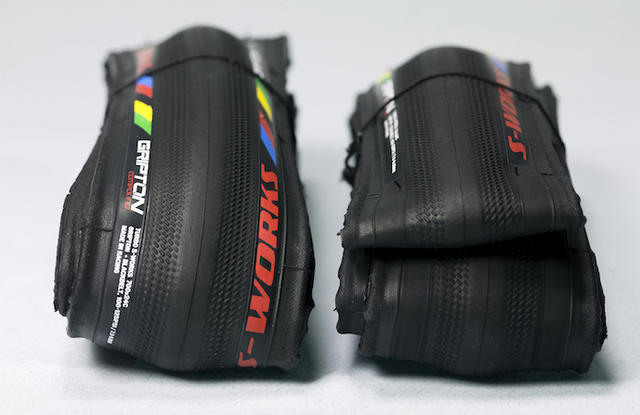Fastest rolling tires of 2015
Posted November 14, 2015 01:59PM by
Skye in the
Cycling Forum
Turns out tread compound is the most important factor in low rolling resistance. Supple sidewalls and wider tires help too. Surprisingly, tubulars were not that faster than clinchers. Full story: VeloNews - Where the rubber meets the road
The Specialized tire line-up performed extremely well, no doubt because they hired Wolf Vorm Walde and Wolfgang Arenz from Continental (the team behind the still very highly ranked GP 4000S II with its Black Chili compound). Maybe my next set of tires will be the Specialized S-Works Turbo with Gripton? The price is sure right.
A little note on their testing procedure: "The tires ranged in width from 22 to 26 millimeters and included standard clinchers, open tubulars, and tubeless versions. We tested them at 40kph with a load of 50 kilograms, each inflated to 116psi. To simulate the way we assumed most people will run these various models, we used 70-gram Bontrager XXX latex inner tubes in higher-end clinchers and 95-gram butyl tubes in less expensive ones. Tubeless tires took 25 grams of Bontrager TLR sealant. All standard clinchers were mounted to Mavic Ksyrium Super Light wheels, while tubeless tires went onto Fulcrum Racing 1 wheels."
What tires and tire width are you using? Let us know by replying below.
Tire performance results:

The Specialized tire line-up performed extremely well, no doubt because they hired Wolf Vorm Walde and Wolfgang Arenz from Continental (the team behind the still very highly ranked GP 4000S II with its Black Chili compound). Maybe my next set of tires will be the Specialized S-Works Turbo with Gripton? The price is sure right.
A little note on their testing procedure: "The tires ranged in width from 22 to 26 millimeters and included standard clinchers, open tubulars, and tubeless versions. We tested them at 40kph with a load of 50 kilograms, each inflated to 116psi. To simulate the way we assumed most people will run these various models, we used 70-gram Bontrager XXX latex inner tubes in higher-end clinchers and 95-gram butyl tubes in less expensive ones. Tubeless tires took 25 grams of Bontrager TLR sealant. All standard clinchers were mounted to Mavic Ksyrium Super Light wheels, while tubeless tires went onto Fulcrum Racing 1 wheels."
What tires and tire width are you using? Let us know by replying below.

Webmaster - Staminist.com
What is an open tubular tire?
I was doing some research into what the heck an "open tubular" is, and came up with this info from manufacturer Challenge.
Take it as marketing hype or not. I suppose with any term that is open to interpretation, it may mean a higher quality tire with some manufacturers, but not with others. However, it seems to me the distinction between vulcanized or non-vulcanized is a significant one.
I can say for a fact that riding around this winter on 33mm file-tread tubulars has been an eye-opening experience, and I would very much like to transfer that kind of ride quality to my "main" bike!
I was doing some research into what the heck an "open tubular" is, and came up with this info from manufacturer Challenge.
Take it as marketing hype or not. I suppose with any term that is open to interpretation, it may mean a higher quality tire with some manufacturers, but not with others. However, it seems to me the distinction between vulcanized or non-vulcanized is a significant one.
I can say for a fact that riding around this winter on 33mm file-tread tubulars has been an eye-opening experience, and I would very much like to transfer that kind of ride quality to my "main" bike!
Quote
An Open Tubular is a tubular that is assembled on the wheel like a standard clincher. The shape in fact is that of a clincher, but the materials used to make it (compound, high TPI carcass) but above all the hand made production process (tread glued by hand on the carcass and no vulcanization process involved at any time) is exactly the same of the tubular.
Therefore the Open Tubular is an extraordinary compromise: a clincher with a tubular-like superior comfort and best road feel, much higher than any other clincher, mainly if a soft latex inner tube is used.
About the price, the Open (open + latex tube) is usually more expensive than a clincher but much cheaper than a tubular.
Since carbon fiber frames are getting so popular, it has become even more important to ride on high quality tires. The road feel given by an Open Tubular with latex inner tube helps the rigid carbon bike to behave in a more comfortable way, absorbing vibrations and transferring to the rider a better quality ride feel from the bike in general.
Be aware that some manufacturers may call "Open Tubulars" some of their standard clinchers in order to sell them at a higher price. You can recognize a real open by the TPI first of all (that needs to be the same of a tubular) and by the softness and flexibility of the tire when you touch it.
Webmaster - Staminist.com

